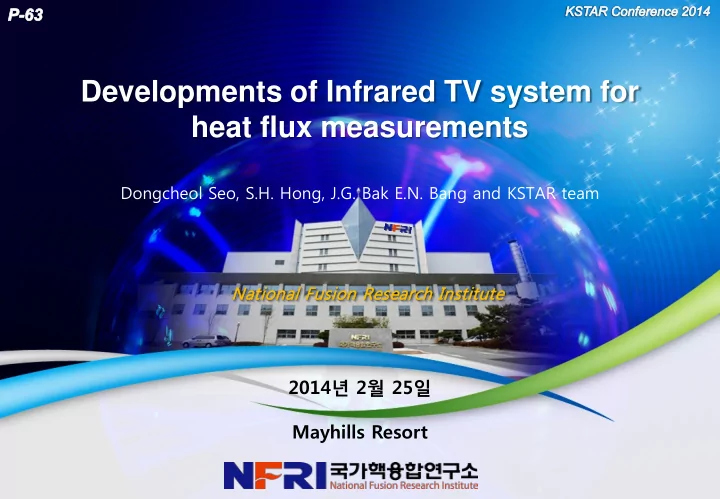

Developments of Infrared TV system for heat flux measurements Dongcheol Seo, S.H. Hong, J.G. Bak E.N. Bang and KSTAR team Natio ional F l Fusio sion Rese search Inst stit itute 2014 년 2 월 25 일 Mayhills Resort
Abstract Surface temperature and heat flux measurements are very important issues in high power fusion devices to guarantee safe long pulse plasma operation. Many fusion devices are to measure surface temperature of the Plasma Facing Components (PFCs) and heat flux measurements using the infrared camera system. The Infrared TV system has been installed in 2010 in Korea Superconducting Tokamak Advanced Research (KSTAR) to monitor the increase of the temperature of the ICRH antenna, and heat flux to the first wall. The specification of the Infrared camera (FLIR/ThermoVision SC6000) are resolution of 640x512 pixels, full frame rate of 125 FPS and Noise equivalent temperature difference (NETD) of less than 25mK. The spatial resolutions are ~ 5.14 mm/pixel at the poloidal limiter and ~5.47 mm/pixel at the outer divertor with a viewing angle of 58 degree. Due to the wide viewing angle, the temperatures at divertor, poloidal limiter, and passive stabilizer have been measured at once. Time resolution of the system is ~10 msec with an exposure time of 0.35msec. 2
Abstract - continue The surface temperature as well as heat flux on the PFCs were measured and estimated by using equation q = κ d T /dn, where κ is thermal conductivity, T is the surface temperature, and n is the index of coordinate normal to the surface (e.g. “z”) with assumption of isotropic single material with no deposition. Heat flux on the surface in L- and H-mode plasmas were obtained, in a range from ~24 kW/m 2 up to ~167 kW/m 2 , which are higher than that measured by thermocouple. In this work, we present details of the Infrared TV system in KSTAR and preliminary measurement results. 3
Infrared TV system IR camera IRTV Lead Soft iron IRVB P.E. IRVB Protective shield for IR camera Specification of IR camera Model : FLIR SC6000HS Resolution : 640x512 pixels Divertor or IRTV TV IRTV Full frame rate : 1 Hz ~ 125 Hz Spectral rage : 3 - 5 μ m NETD : <25mK Poloidal Detector type : Indium Antimonide limiter (InSb) Measurement range : 0 ° C ~ 1500 ° C Data resolution : 14 bit Layout of the Heating systems and IR image diagnostics 4
Control Hardware composition Configuration of the control system for IRTV diagnostics 5
FOV of the IR camera Poloidal limiter I.L. L. -2.3 .3 -1.8 .8 -1.3 .3 0 P.S .S. O.D. IR image and 3D cad image of the Field of View 6
Data analysis Fourier’s law 𝑟 = −𝜆 𝜖𝜖 𝜖𝜖 where, 𝑟 is the heat transfer per unit area, 𝜆 is the thermal conductivity and 𝜖 is the temperature. The surface temperature rise 𝛦𝜖 in case the semi-infinite solid is given by 𝑢 1 ( 𝜌𝜆𝜌𝐷 𝑞 ) 1 / 2 � 𝑄 ( 𝑢−𝜐 ) 𝛦𝜖 = d 𝜐 𝜐 1 2 ⁄ 0 where, 𝐷 𝑞 is the specific heat, 𝜆 is the thermal conductivity and 𝜌 is the density of the solid. for constant 𝑄 1 / 2 𝑢 𝛦𝜖 = 2𝑄 𝜌𝜆𝜌𝐷 𝑞 7
Temperature Calibration Model : IR-564/301 Specifications: Temperature Range: 50 – 1200 C Emittance Watts/Cm^2 (Watts): 26.68 (135) Wavelength Range: 0.5 - 99um Emissivity: >0.99 Emitter Size: in (mm) 1" (25.4) Source Type: Cavity Temperature Resolution: 0.1 C Calibration Accuracy: +/- 0.2 C to NIST Standard Stability: Short (Long) Term: +/- 0.1 C (+/- 0.2C) Response Time: 100-1200 <70 Minutes 8
Heat flux analysis Thermogr graph phy #9422 t = 2 2.95s I.L. L. P.S .S. O.D. Heat f flux ux density Analysis area for O.D. Heat flux profile for O.D 9
Comparison between TC, IR and probe at divertor Temperature ( ℃ ) 1 3 5 Profile position Comparison area 10
SUMMARY Summary Installation of the shielding box for protection of the IR camera from the Neutron, magnetic field. Investigation of the Heat flux at the poloidal limiter and the out board divertor Evaluation the profile of the heat flux density on the out board divertor. Comparison between the IR thermography and the thermal couple measurement in the divertor region. Future work Improvement of the IR thermography measurement for evaluation of the heat flux at divertor target. Further work for comparison between IR thermography and probe measurement. 11
Recommend
More recommend